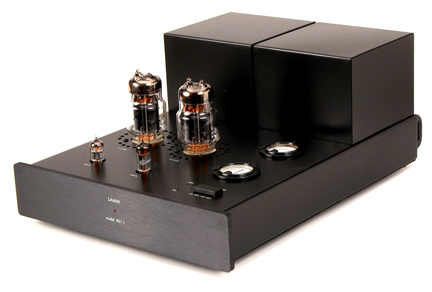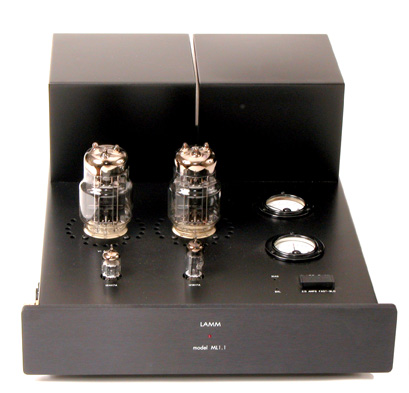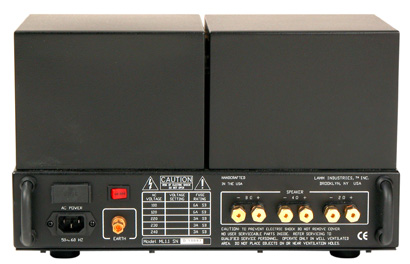You are reading the older HTML site
Positive Feedback ISSUE
15
september/october 2004
lamm industries
ML1.1 monoblock amplifiers, Part 1
as reviewed by Marshall Nack

Photographs courtesy of Lamm Industries, Inc.; image processing by David W. Robinson.
|
MARSHALL NACK'S SYSTEM
LOUDSPEAKERS
ELECTRONICS
SOURCE
CABLES
ACCESSORIES
|
Once again, yours truly finds himself in super amp territory. Let me tell you, this is very easy to get used to. This time around I'm hosting the Lamm ML1.1 mono amps. As with all Lamm gear, their reputation preceded them, and I found it to be prophetic.
These amps easily do all the things audiophiles look for. I'm sure most listeners will not have any reservations concerning the ML1.1s tonal balance, detail retrieval, neutrality and accuracy, dynamics, sound-staging... I could go on and list every criterion on the audiophile report card. Instead, I'll just briefly review a few attributes, so we can quickly get to the exceptional stuff.
Some housekeeping
I found the frequency spectrum perfectly apportioned, without exaggeration or deficiency. Transitions from one frequency to the next were seamless—actually, they were unnoticed. I've heard this kind of continuousness before in the solid-state darTZeel NHB-108 stereo amp, where the treble seemed to emerge organically out of the mid-band. However, I've never heard it from a powerful low-end on up. The treble, especially, transitions seamlessly, maybe even a bit obsequiously. It might seem like it could use more extension, but that's because it isn't pointed or bright. Unlike the kind of treble I'm used to, there isn't even a hint of brightness and it has the same amount of body as the other bands. The bass is quite similar in its integration, but not at all obsequious. The ML1.1 doesn't lack for slam when it's required.
All this wouldn't be interesting if the amps threw skinny, under-nourished, etched outlines of images. Instead they put out a layered soundscape populated with realistically sized—sometimes oversized—full-bodied images. Nothing is vague or hazy here: soft edged images, often with individual depth, are precisely located. The stage is neither forward nor recessive, but about mid-point.
Tonally, the center of gravity is in the midrange and similar to that of my von Gaylord Audio Nirvana tube mono-blocks, or the solid-state darTZeel, but lighter than the Mastersound 845 tube SET monos. However, you will have no difficulty discerning that the ML1.1s are not an SET by their lack of that device's signature warmth or lushness, flabby bass and dull, blunted treble. They ain't romantic. On the other hand, they are far from dry or analytical. For that matter, they don't sound particularly like push-pull tube amps either. To say that the ML1.1 is neutral and accurate as well as even-handed and full-bodied is a good start.
Beyond all of this, which is perhaps 96% of the game, you may or may not be entirely simpatico with their voice—perhaps you prefer a soupcon more bloom, a more dynamic bass, etc. This gets into the realm of personal preferences, which I prefer to stay clear of for the moment. I'd rather convey as best I can some of the things I heard the ML1.1 do which transcend the usual performance paradigm.

It's mostly about control
To my mind, in the forefront of the personality of these big, 90-watt, all-tube, push-pull mono amps is overwhelming and compassionate control.
I don't think anybody will object to control being called a good thing since it's something we all want more of. There are all kinds of things we need to control in a sound room, and there are at least as many ways to get the job done. One is offered by after market tweaks like isolation footers and damping weights, which address resonances. Then there are the EMI/RFI blockers to keep environmental pollution at bay. Another approach is offered by the variety of acoustic treatments that bring the room into the equation. Note that these methods are not redundant; they address different factors that cause sonic degradation and you need to consider them all. And then there is the kind that's built into some components, like the Lamm ML1.1.
Maybe "control" isn't exactly the right word to describe what I don't hear, i.e., the usual mechanical noise and other "stuff" riding along with the signal, and the usual exaggerations. Exquisite handling plus control is more apt. These amps pass the signal along using velvet gloves, not quite caressingly, but carefully, so as to avoid causing harm, eventually delivering it intact just where it's supposed to go.
Simple Purity
First, let's talk about what the ML1.1s don't do. Have you ever noticed odd, mechanical and unnatural noises during playback, spurious sounds that don't make musical sense, that couldn't have been present at the recording? No? Well, neither did I, until I lived with the ML1.1s for a while and then swapped them out.
Let's focus on frequency and time coherency for a moment. Natural sound is complex, immediate, incredibly dynamic, right? The frequency content consists of the principle note and its wealth of overtones tuned to sympathetic frequencies, which can be measured, but that's it: what we hear is either the note or its overtones. Without diminishing its complexity, in a sense the purity of natural sound is more straightforward and simpler than we think. Typically, our audio systems screw this up—we short-change the overtones or the principle note, while introducing any number of amusical add-ons, both reducing and polluting the signal at the same time.
Moving on to time coherency, natural acoustic sounds come and go quickly—instantaneously—with 100% frequency participation in a solid transient wave front, and then dissipate equally coherently. Sometimes the fast dissipation and lack of any lingering sounds can seem dry (except, of course, if you're in a reverberant concert hall). For a component to replicate this kind of wave front and wave end requires great effort on the part of the designer. The component has to intentionally be made to achieve this. Maybe it requires a small amount of selective damping, something that helps all frequencies start and stop faster while keeping some from lagging. Few components get it right.

Blazing Saddles + blinding speed - Great pace!
Intelligent choices were made in the case of the ML1.1s. They deliver the kind of purity and coherence that I hear in live music. The decay component is neither exaggerated, nor shortened: it lingers just long enough to render the signal convincingly, and then goes away. You get the impression there's some degree of damping at work giving the ML1.1s a staccato quality. Many amps do just the opposite, holding onto trails and extending reverberations, giving them a legato quality. The impression of speed with the ML1.1s is also aided by the high output damping factor, which makes sure the speaker drivers are well controlled with little overhang.
Whatever else is going on, it's clear that the ML1.1s are fast as blazes. With fantastic transient capabilities, they can unleash ferocious, almost cruel orchestral thunder, then turn on a dime for a whisper quiet, intimate flute solo rendered with a hint of SET-like sweetness and grace. While dynamics are truly splendid, I wouldn't call them loose or freewheeling, as in some designs which lack such control. Likewise for treble extension: voices and instruments go where they need to go, exhibiting dynamic and tonal freedom, but the amps make sure they don't start wandering around on you or acquiring artifacts. They tightly hold onto the signal, in a sense protecting it, so it doesn't pick up artifacts en route. With the ML1.1s, you never experience an instrument run amuck, as in so many high-end systems where sudden dynamic peaks can become raucous, exhibiting unpleasant qualities that weren't there before. The system has lost control for those brief periods. The ML1.1s hold onto the instantaneous peak SPL. Even when the recording meter has obviously gone into the red saturation zone on a too closely miked trumpet, for example, the amps handled it without compounding the breakup.
What they do well
The ML1.1s replicate the simple purity that you'll easily associate with real sound. Equally important, they don't subtract anything: they come as close to giving you the full complexity of source information as you're bound to find in today's offerings.

One night at the opera, I had the pleasure of seeing Renee Fleming in the title role of Dvorak's Rusalka. What a performance! At intermission, my friend pointed out the sheer density of information emanating from the stage. He bemoaned that high-end audio is far from replicating all that complexity and concluded, "Quite likely we will never be able to do it."
I think the more accessible part of what he was talking about is what we refer to as detail retrieval. There are some components that can throw amazing, almost overwhelming walls of information at you. The Chateau Research Anaco 2 stereo digital amp is a champ for its sheer density of information. The ML1.1s can't match that feat—however, they surpass the Chateau in what they do with the details. Within a soundstage like that in Cecilia Bartoli's wonderful recording LIVE in ITALY (London 289 455 981-2), the harpsichord in the basso continuo can easily get smothered, the quality of its small percussive plinks lost in the mix, leaving you with vague treble sounds. The ML1.1 manages to give the harpsichord the necessary support to maintain its integrity so you can sustain your suspension of disbelief. Secondary events are rendered with the same integrity as the main ones. Swap out the ML1.1s and you lose the verisimilitude of these secondary phenomena. Sure, the main event will be there, but the harpsichord turns limp and loses its interest—and Cecilia's forté passages lose the sure-fire control described above.
Texture and sound-pixels
On a deeper level, what my friend was talking about is a much more subtle, almost unnoticed kind of event. Most ears perceive the major events without any effort during an un-amplified concert. Close your eyes, focus your attention and soon you can discern smaller events within the major ones. Keep concentrating and you will probably resolve an even finer layer. This pattern repeats—there seems to be no end of discernable differences—until eventually you come to a level where apparently nothing is happening. This will be on long, evenly sustained notes. However, if you listen closely, you can still hear things, even on that level. Sustained sound is really like a finely woven cloth; it is never totally smooth and without texture. My friend and I decided to think of this substructure as "sound-pixels." In reproduced sound the base level of sound pixels is usually disguised by what audiophiles call grain, a byproduct of the process.
We typically think of solid-state gear as grainy, i.e. comprised of coarse particles you can actually hear, and that you know are an artifact. Likewise, we often say tube gear is fine-grained, or even grainless, that is, not evidencing discernable grain. My von Gaylord Audio tube amps have no apparent grain and reveal a smooth, undifferentiated surface. But neither type gives a hint of the textured base level—the sound pixels.
I'll be darned if I wasn't hearing some of that texture thing from the ML1.1s! Instead of smoothness on the one hand, or grain on the other, they don't have a discernable grain structure. With that limitation out of the way, their micro-resolving power (another new word for our lexicon) comes to the fore. They weave a very fine cloth and are the only gear I've heard that allows a peak at the little "sound-pixels."

Tweaks and Cosmetics
The ML1.1 doesn't need much in the way of tweaks to sound good. For most of the review I used Combak Harmonix RFS-66 footers, which were upgraded midway through to the Harmonix TU-202 ZX. The large TU-202 ZX come in sets of four, but using just two per amp did the trick. Be careful if you use just two because most of the amp's 70 lbs of weight is under the toroidal power transformer on the right side. By the way, the output transformer on the left gives a pleasant ring when rapped with a knuckle.
Another friend who had long experience with the ML1s, the direct predecessor to the ML1.1s, brought over some Shun Mook diamond resonators one evening. I know these products have a somewhat controversial mystique about them; however, I heard interesting changes. Although tonally not much different, the space expanded in all directions, and an enhanced natural acoustic unfurled. The width of the stage was more densely populated—whatever gaps, or deep black holes, there had been between instruments were filled in.
Speaker wires that worked well included the Harmonix HS-101 SLC, Analysis Plus Golden Oval and the new Oval 8, which sounded very good at a fraction of the price, Argent Pursang-S, and von Gaylord Audio. Interconnects included the Argent Pursang-S, Harmonix, Harmonic Tech Magic, von Gaylord Audio and Stealth GS-50-50. Best results for power cords were the Golden Sound Red Plus (a beefed-up version of the GS Red PC). As you see, almost all of my reference wires were compatible. The amp has both single-ended and XLR inputs, but it becomes single-ended internally. I tried the same cable with XLR and single-ended termination and found the sound quality and loudness equal. The XLR input is really there for convenience, in case you happen to own an expensive balanced cable.
The Operating Manual states, "The optimum performance will be achieved by using two independent 15 amp AC lines." This was indeed the case. I briefly had dedicated Shunyata Hydra's on each amp, and summarily removed them. The amps have built-in conditioning and work best straight into the wall. There's a very long warm-up delay—two minutes after you turn them on, then about ˝ hour playing time to settle. There was absolutely no noise through the speakers. I had to put my ear within inches from the tweeter to hear any hiss. Lamm must be doing something pretty special in terms of solving grounding problems.
The ML1.1 is a large, serious-looking component, "employing a unique high current low impedance vacuum tube power triode in the output stage." This is the now fairly common Russian sourced 6C33C tube. Two retro, circular meters monitor the idle and maximum plate current and the bias of these output tubes, which are easily adjustable via a setscrew and a small screwdriver. "The goal was to utilize... modern technology and processes while recreating a look reminiscent of the long-gone genuine vacuum tube era." Yeah, they do have an antique look about them; not overbuilt or luxuriously finished, but tempered by clean lines and industrial/military build quality.
Conclusion
The Lamm Industries' ML1.1 amplifiers are definitely reference class. They are a superbly-voiced instrument that pushes the performance envelope on several fronts. Balancing the need to protect the fragile signal from acquiring pollutants on the one hand and avoid reducing or embellishing it on the other, the ML1.1 manages to deliver a signal that is both artifact-free and faithful to the source. You'll find its simple purity refreshing, its time coherency realistic, its transient speed and power invigorating. The upshot is you'll spend less time dodging and filling and more time enjoying.
The Lamm ML1.1 brings to mind the skills of well-trained dancers who must be deliberate and graceful at the same time. They must rigorously follow the choreographer's intention without adding anything extraneous. When done well, the resulting performance is elegant, simple, graceful and tightly controlled. "Discipline is Freedom," the title of a dance Garth Fagan choreographed to a Dollar Brand score, could just as well apply to the ML1.1.
ML1.1 amplifiers
Retail: $22,890 pair
Specifications
-
Push-pull tube mono-block amplifier.
-
Tube complement: one 12AX7/ECC83, first amplification stage; one 12BH7A, second amplification stage; two 6C33C-B, output stage.
-
Rated Output Power: minimum continuous sine-wave power, from 20Hz-20KHz, with no more than 2% THD @ rated line voltage 80 Watts into 8 Ohms.
-
Inputs: one single-ended RCA, one balanced XLR.
-
Outputs: Three sets of gold plated binding posts (2, 4, 8 ohms)
-
Dimensions: 8.25 inches (21cm) high x 16 inches (40.64cm) wide x
-
20.375 inches (51.75cm) deep [add 1.3125 inches (3.3cm) for handles located on rear panel]
-
Unit weight: 70 Lbs. (31.78 Kg) installed.
-
Serial Numbers: D10117, D10118
-
Warranty: 5 years
Lamm Industries,
Inc.
2621 East 24th
Street
Brooklyn, NY 11235
TEL:
718. 368. 0181
email address:
[email protected]
web address:
www.lammindustries.com
